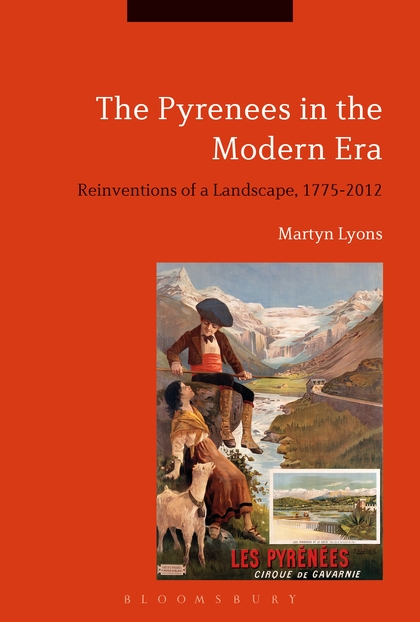
This is part of our special feature on Food, Food Systems, and Agriculture.

Beginning with the concept that landscapes are “unstable and highly constructed,” (1), Martyn Lyons sets out to decode the region between France and Spain, including Andorra, along the Pyrenee mountain range. Drawing on traveler accounts from the late eighteenth through the twentieth centuries, as well as official tourist publications, memoirs, and regional newspapers, Lyons takes a transnational approach to understand exchanges, conceptions, and ideas that flourished in the region. His sources are somewhat biased, leaning more to French than Spanish, in part due to Lyons’ career as a French historian but also due to the fact that the French side of the mountains became, from the nineteenth century through the twenty-first the preferred destination of traveler, more of whom were French than Spanish (7-8). The result is an important work that seeks to understand a border without a distinct “Pyrenean” identity but also one without solid national divisions, where social, economic and political crossings were, and are, common.
Lyons begins his study in the age of Enlightenment, when geological scientists from other parts of France began to visit the Pyrenean region to gather empirical evidence about the age of the earth that ultimately would challenge the Biblical narrative common in society. This initial era of tourism expanded greatly in the Romantic period of the nineteenth century, when visitors came to the mountains in search of “picturesque” landscapes meant to “move the soul” (49) and, in a way, was emblematic of Romanticism’s struggle with modernity and yearning for a more pristine past. Seeing the Pyrenees as a region soon was complicated by the creation of and articulation of national identity, especially in French and British conceptions of the Spanish as “other,” especially for British Protestants, French liberals and the travelling middle- and upper-classes. The Spanish tradition of bullfighting, even though a peripheral event in the Pyrenees compared to southern Spain, produced a “sickening disgust” in many travellers throughout the nineteenth century, which reinforced these emerging perceptions of national character (67).
Yet, despite these findings, Lyons encourages the reader to complicate any pre-existing perceptions about the solidity of the border. Despite a series of treaties going back to the Treaty of the Pyrenees in 1659 and the Three Treaties of Bayonne in 1856, 1862 and 1868, earlier understandings about the border made amongst villagers in the region, not politics and map-making coming from national capitals, shaped the border’s creation. One of these was an oath of peace acted out in a formal ceremony between villagers of Barétous, France and Roncal, Spain that went back to the fourteenth century (125). Other judicial agreements amongst villages across borders were not uncommon, as were smuggling routes related to taxation and conflict in the different states. The rise of Basque and Catalan nationalism in the nineteenth century and their perceptions of the frontier dividing up their own national lands further complicated matters. Indeed, Lyons shows how Basque nationalists ideologically refused to accept the border, yet how the separatist group ETA (Euskadi ta Askatasuna) often used the border to its advantage, offering France as a refuge for militants to escape arrest and prosecution by the Spanish police (136). The Catalan nationalist movement came to see the Pyrenee mountains as a nationalized landscape, one that united French and Spanish Catalans. Andorra, which has grown to 80,000 people, mostly foreign, due to its status as a tax haven, both embraces and defies the imposition of Spanish and French rules. Lyons admirably demonstrates how frontiers and borderlands are flexible, malleable, constructed and, at times, real things.
This is especially true in his chapter on the borderland during the Second World War. The flight of some 450,000 Spaniards into France at the end of the Spanish Civil War, in January and February 1939, and the work of over 2,500 human smugglers moving some 33, 000-80,000 refugees across the Pyrenees during the Nazi occupation of France from 1940-1944 made the frontier very real, a matter of life and death. Changing policies on refugees from the dictatorial regime of General Francisco Franco in Spain greatly influenced this period, from harassment over papers, especially early on, to acceptance, movement to an internment camp and facilitation of exit to North Africa, Portugal or elsewhere by 1943 and 1944. Some of those assisting in the movement of people over the mountains were Communists anarchists, motivated by their opposition to Nazism and Francoism; others were profiteers, demanding significant payment for passage. Nonetheless the experience of a firmer border than had existed in the past became an important story of war.
Lyons charts the rise of mass tourism to the region in the second half of the nineteenth century, the enthusiasm of mountaineers and cyclists, including the arrival of the Tour de France in 1910. He also looks at issues since the Second World War, such as the creation of national parks and reserves meant to protect bears and other wildlife that imposed restrictions on hunting and other village traditions. The increasingly fragile status of shepherds and the pastoral economy is noted. For example, some 60 percent of small farms disappeared in the French region of Ariège from1979-2000 (187). Regional autonomy, village custom, and economic distress have led to small-scale protests and opposition to government on both sides of the border in the last part of the nineteenth and into the twenty-first century.
Martyn Lyons concludes that the region as a whole has a history of constant reinvention. It is neither a firm frontier or a completely open one; it is not a region dominated by central government nor one with a distinct and clear regional identity; it is a region framed largely by outsiders and tourists over many generations, who either ignored or idealized the locals and their customs and traditions. He thus is very convincing in demonstrating the variety of different constructions the landscape has been subject to, and how such constructions reflect the larger historical period they emerged from and the larger concerns of outsiders and tourists. Understanding that process as constant and never-ending is crucial to understanding the region and its role in France, Spain, and Europe.
Reviewed by David A. Messenger, University of South Alabama
The Pyrenees in the Modern Era: Reinventions of a Landscape, 1775-2012
By Martyn Lyons
Publisher: Bloomsbury
Hardcover / 267 pages / 2018
ISBN: 9781350024793
To read more book reviews click here.
Published on September 5, 2018.




